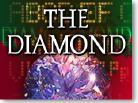|
Diamond shines on Amex
|
 |
January 20, 1998: 6:18 p.m. ET
Investors buy more than 1.7 million shares of new security on Tuesday
|
NEW YORK (CNNfn) - The American Stock Exchange on Tuesday unveiled a new type of index trading for small investors who want a cheaper way to put their money in blue chips.
The new product -- called a Diamond -- trades like a stock but acts like a mutual fund by representing the 30 companies that comprise the Dow Jones industrial average.
"It will be successful because the individual investor doesn't look at any other indicator than the Dow," said Joseph Stefanelli, executive vice president of derivative securities at the Amex.
Trading under the symbol (DIA), each Diamond is worth about one percent of the value of the Dow. Based on the Dow's close of 7873.12 Tuesday, one Diamond would cost about $78.73.
About 1.74 million shares of Diamonds changed hands at the close of trading Tuesday.
"Any new (investment) vehicle is welcome in the financial community," said Peter Cardillo, director of research at Westfalia Investments. "Any time you have something that's tilted towards the small investor, it's going to have sex appeal."
John Rekenthaler, president of John Nuveen & Co., an investment management firm based in Chicago, said the Dow name will carry weight with investors.
"The Dow Jones is the far most visible index," Rekenthaler said. (150K WAV) or (150K AIFF)
The Diamond is a share in a unit investment trust, which is a portfolio of stocks that isn't managed and doesn't change.
One advantage of the Diamond is it acts like a mutual fund by offering investors an easy way to diversify, Stefanelli said.
With one purchase, a buyer gets his hands on such Wall Street titans as AT&T (T), Boeing Co. (BA), IBM (IBM), and Coca Cola Co. (KO).
But Diamonds also mirror a stock because they can be traded throughout the day, Stefanelli said. Mutual fund shares are based on closing stock prices.
"It has the best that a mutual fund has to offer … as well as the beauty of owning a stock," Stefanelli said.
While buyers will still have to pay a commission, Stefanelli said they will save thousands over the cost to buy stock in all of the Dow 30 companies.
Based on Tuesday's closing stock prices, a person would spend more than $2,000 to buy one share of all 30 companies in the average.
Another plus with the Diamond is the fees are lower than with a no-commission index mutual fund. A fee for a Diamond is .18 percent of the yield, compared with .2 percent for the fund.
Investors can also short-sell Diamonds without worrying about an expiration date.
But Cardillo questioned introducing the Diamond when the market is so volatile. Asian turmoil has triggered substantial swings in U.S. stocks in January, making some market watchers bearish.

"People are being more cautious and perceptions have changed," Cardillo said. "I suspect (the Diamond) isn't going to be as popular as it would have been if it came out during a different time."
Stefanelli argued the timing was unintentional. The Dow didn't even allow licensing of its name until October 1997, when it permitted the Chicago Board of Trade to trade options and futures on the Dow.
The Amex had to wait even longer to introduce the Diamond because it needed to be reviewed by the Securities and Exchange Commission, Stefanelli said.
This isn't the first index trading on floor of the Amex. The exchange in 1993 started offering a similar product geared for institutional investors called a Spider (SPY) that mirrors the S&P 500. Professional investors most commonly use the S&P 500 as a benchmark, Stefanelli said.
The S&P outperformed the Dow in 1997 by almost 10 percent. The S&P 500 had returns of 31.01 percent, compared with 22.64 percent for the Dow.
But Amex officials argue that returns change from year to year. Investors can decide for themselves whether they want to invest in the Dow or the S&P units.
"We always wanted to trade the Diamond and the Spider," Stefanelli said.
-- By staff writer Martine Costello
|
|
|
|
|
 |

|

